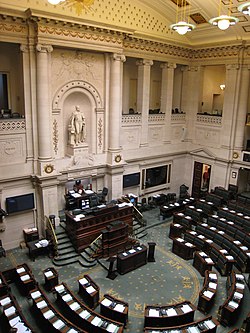| Palace of the Nation | |
|---|---|
 Front view of the Palace of the Nation seen from the Rue de la Loi/Wetstraat | |
 | |
| Former names | Palace of the Council of Brabant |
| General information | |
| Architectural style | Neoclassical |
| Address | Place de la Nation / Natieplein 2 |
| Town or city | 1008 City of Brussels, Brussels-Capital Region |
| Country | Belgium |
| Coordinates | 50°50′49″N4°21′54″E / 50.84694°N 4.36500°E |
| Current tenants | Belgian Federal Parliament |
| Construction started | 1778 |
| Completed | 1783 |
| Other information | |
| Public transit access | |
The Palace of the Nation (Dutch : Paleis der Natie; [a] French : Palais de la Nation; [b] German : Palast der Nation) [c] is a neoclassical palace in Brussels, Belgium, housing the Belgian Federal Parliament. The Parliament consists of both the Chamber of Representatives (lower house) and the Senate (upper house), which convene in two separate hemicycles.
Contents
- History
- Austrian Netherlands
- United Kingdom of the Netherlands
- Kingdom of Belgium
- Gallery
- See also
- Notes
- References
- Citations
- Bibliography
- External links
The palace was built from 1778 to 1783 to a neoclassical design by the French architect Gilles-Barnabé Guimard and includes sculptures by Gilles-Lambert Godecharle. Under Austrian rule, it housed the Sovereign Council of Brabant before being used as a courthouse during the French period. During the Dutch period, it was one of two homes of the Parliament of the United Kingdom of the Netherlands, the other being in The Hague. The palace was partially rebuilt at that time by the architect Charles Vander Straeten. Following Belgian independence in 1830, the Provisional Government of Belgium and Belgian National Congress moved into the building and the first session of the Chamber of Representatives and Senate was held there a year later. [1]
The building stands across the street from Brussels Park's northern entrance, near the site of the former palace of the Dukes of Brabant, which was destroyed by fire in 1731, and has itself been badly damaged by fire, in 1820 and 1883. [2] In the 1930s, a bunker was built underneath the park, connected by tunnels to the House of Parliament. [3] This area is served by Brussels-Central railway station, as well as by the metro stations Parc/Park (on lines 1 and 5) and Arts-Loi/Kunst-Wet (on lines 1, 2, 5 and 6).






